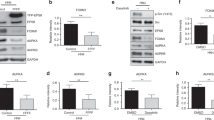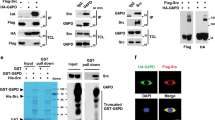Abstract
c-Src is upregulated in various human cancers, suggesting its role in malignant progression. However, the molecular circuits of c-Src oncogenic signaling remain elusive. Here we show that Fer tyrosine kinase oligomer mediates and amplifies Src-induced tumor progression. Previously, we showed that transformation of fibroblasts is promoted by the relocation of c-Src to non-raft membranes. In this study, we identified Fer and ezrin as non-raft c-Src targets. c-Src directly activated Fer by initiating its autophosphorylation, which was further amplified by Fer oligomerization. Fer interacted with active c-Src at focal adhesion membranes and activated Fer-phosphorylated ezrin to induce cell transformation. Fer was also crucial for cell transformation induced by v-Src or epidermal growth-factor receptor activation. Furthermore, Fer activation was required for tumorigenesis and invasiveness in some cancer cells in which c-Src is upregulated. We propose that the Src–Fer axis represents a new therapeutic target for treatment of a subset of human cancers.
This is a preview of subscription content, access via your institution
Access options
Subscribe to this journal
Receive 50 print issues and online access
$259.00 per year
only $5.18 per issue
Buy this article
- Purchase on Springer Link
- Instant access to full article PDF
Prices may be subject to local taxes which are calculated during checkout








Similar content being viewed by others
References
Jove R, Hanafusa H . Cell transformation by the viral src oncogene. Annu Rev Cell Biol 1987; 3: 31–56.
Brown MT, Cooper JA . Regulation, substrates and functions of src. Biochem Biophys Acta 1996; 1278: 121–149.
Nada S, Okada M, MacAuley A, Cooper JA, Nakagawa H . Cloning of a complementary DNA for a protein-tyrosine kinase that specifically phosphorylates a negative regulatory site of p60c-src. Nature 1991; 351: 69–72.
Nada S, Yagi T, Takeda H, Tokunaga T, Nakagawa H, Ikawa Y et al. Constitutive activation of Src family kinases in mouse embryos that lack Csk. Cell 1993; 73: 1125–1135.
Okada M . Regulation of the SRC family kinases by Csk. Int J Biol Sci 2012; 8: 1385–1397.
Irby RB, Mao Y, Coppola D, Kang J, Loubeau JM, Trudeau W et al. Activating SRC mutation in a subset of advanced human colon cancers. Nat Genet 1999; 21: 187–190.
Irby RB, Yeatman TJ . Role of Src expression and activation in human cancer. Oncogene 2000; 19: 5636–5642.
Yeatman TJ . A renaissance for SRC. Nat Rev Cancer 2004; 4: 470–480.
Hunter T, Sefton BM . Transforming gene product of Rous sarcoma virus phosphorylates tyrosine. Proc Natl Acad Sci USA 1980; 77: 1311–1315.
Rous P . A sarcoma of the fowl transmissible by an agent separable from the tumor cells. J Exp Med 1911; 13: 397–411.
Stehelin D, Varmus HE, Bishop JM, Vogt PK . DNA related to the transforming gene(s) of avian sarcoma viruses is present in normal avian DNA. Nature 1976; 260: 170–173.
Takeya T, Feldman RA, Hanafusa H . DNA sequence of the viral and cellular src gene of chickens. 1. Complete nucleotide sequence of an EcoRI fragment of recovered avian sarcoma virus which codes for gp37 and pp60src. J Virol 1982; 44: 1–11.
Frame MC . Src in cancer: deregulation and consequences for cell behaviour. Biochem Biophys Acta 2002; 1602: 114–130.
Oneyama C, Hikita T, Nada S, Okada M . Functional dissection of transformation by c-Src and v-Src. Genes Cells 2008; 13: 1–12.
Hakak Y, Martin GS . Ubiquitin-dependent degradation of active Src. Curr Biol 1999; 9: 1039–1042.
Laszlo GS, Cooper JA . Restriction of Src activity by Cullin-5. Curr Biol 2009; 19: 157–162.
Oneyama C, Hikita T, Enya K, Dobenecker MW, Saito K, Nada S et al. The lipid raft-anchored adaptor protein Cbp controls the oncogenic potential of c-Src. Mol Cell 2008; 30: 426–436.
Oneyama C, Iino T, Saito K, Suzuki K, Ogawa A, Okada M . Transforming potential of Src family kinases is limited by the cholesterol-enriched membrane microdomain. Mol Cell Biol 2009; 29: 6462–6472.
Greer P . Closing in on the biological functions of Fps/Fes and Fer. Nat Rev Mol Cell Biol 2002; 3: 278–289.
Itoh T, Hasegawa J, Tsujita K, Kanaho Y, Takenawa T . The tyrosine kinase Fer is a downstream target of the PLD-PA pathway that regulates cell migration. Sci Signal 2009; 2: ra52.
Kogata N, Masuda M, Kamioka Y, Yamagishi A, Endo A, Okada M et al. Identification of Fer tyrosine kinase localized on microtubules as a platelet endothelial cell adhesion molecule-1 phosphorylating kinase in vascular endothelial cells. Mol Biol Cell 2003; 14: 3553–3564.
Lennartsson J, Ma H, Wardega P, Pelka K, Engstrom U, Hellberg C et al. The Fer tyrosine kinase is important for platelet-derived growth factor-bb-induced signal transducer and activator of transcription 3 (STAT3) protein phosphorylation, colony formation in soft agar, and tumor growth in vivo. J Biol Chem 2013; 288: 15736–15744.
Allard P, Zoubeidi A, Nguyen LT, Tessier S, Tanguay S, Chevrette M et al. Links between Fer tyrosine kinase expression levels and prostate cell proliferation. Mol Cell Endocrinol 2000; 159: 63–77.
Kawakami M, Morita S, Sunohara M, Amano Y, Ishikawa R, Watanabe K et al. FER overexpression is associated with poor postoperative prognosis and cancer-cell survival in non-small cell lung cancer. Int J Clin Exp Pathol 2013; 6: 598–612.
Li H, Ren Z, Kang X, Zhang L, Li X, Wang Y et al. Identification of tyrosine-phosphorylated proteins associated with metastasis and functional analysis of FER in human hepatocellular carcinoma cells. BMC Cancer 2009; 9: 366.
Menges CW, Chen Y, Mossman BT, Chernoff J, Yeung AT, Testa JR . A phosphotyrosine proteomic screen identifies multiple tyrosine kinase signaling pathways aberrantly activated in malignant mesothelioma. Genes Cancer 2010; 1: 493–505.
Miyata Y, Kanda S, Sakai H, Greer PA . Feline sarcoma-related protein expression correlates with malignant aggressiveness and poor prognosis in renal cell carcinoma. Cancer Sci 2013; 104: 681–686.
Anastassiadis T, Deacon SW, Devarajan K, Ma H, Peterson JR . Comprehensive assay of kinase catalytic activity reveals features of kinase inhibitor selectivity. Nat Biotechnol 2011; 29: 1039–1045.
Heiska L, Melikova M, Zhao F, Saotome I, McClatchey AI, Carpen O . Ezrin is key regulator of Src-induced malignant phenotype in three-dimensional environment. Oncogene 2011; 30: 4953–4962.
Mak H, Naba A, Varma S, Schick C, Day A, SenGupta SK et al. Ezrin phosphorylation on tyrosine 477 regulates invasion and metastasis of breast cancer cells. BMC Cancer 2012; 12: 82.
Inoue K, Sone T, Oneyama C, Nishiumi F, Kishine H, Sasaki Y et al. A versatile nonviral vector system for tetracycline-dependent one-step conditional induction of transgene expression. Gene Ther 2009; 16: 1383–1394.
Craig AW, Zirngibl R, Greer P . Disruption of coiled-coil domains in Fer protein-tyrosine kinase abolishes trimerization but not kinase activation. J Biol Chem 1999; 274: 19934–19942.
Guo C, Stark GR . FER tyrosine kinase (FER) overexpression mediates resistance to quinacrine through EGF-dependent activation of NF-kappaB. Proc Natl Acad Sci USA 2011; 108: 7968–7973.
Kim L, Wong TW . The cytoplasmic tyrosine kinase FER is associated with the catenin-like substrate pp120 and is activated by growth factors. Mol Cell Biol 1995; 15: 4553–4561.
Kim L, Wong TW . Growth factor-dependent phosphorylation of the actin-binding protein cortactin is mediated by the cytoplasmic tyrosine kinase FER. J Biol Chem 1998; 273: 23542–23548.
Ishizawar R, Parsons SJ . c-Src and cooperating partners in human cancer. Cancer Cell 2004; 6: 209–214.
Tsukita S, Oishi K, Sato N, Sagara J, Kawai A, Tsukita S . ERM family members as molecular linkers between the cell surface glycoprotein CD44 and actin-based cytoskeletons. J Cell Biol 1994; 126: 391–401.
Tsukita S, Yonemura S . Cortical actin organization: lessons from ERM (ezrin/radixin/moesin) proteins. J Biol Chem 1999; 274: 34507–34510.
Yu Y, Khan J, Khanna C, Helman L, Meltzer PS, Merlino G . Expression profiling identifies the cytoskeletal organizer ezrin and the developmental homeoprotein Six-1 as key metastatic regulators. Nat Med 2004; 10: 175–181.
Elliott BE, Qiao H, Louvard D, Arpin M . Co-operative effect of c-Src and ezrin in deregulation of cell-cell contacts and scattering of mammary carcinoma cells. J Cell Biochem 2004; 92: 16–28.
Craig AW, Zirngibl R, Williams K, Cole LA, Greer PA . Mice devoid of fer protein-tyrosine kinase activity are viable and fertile but display reduced cortactin phosphorylation. Mol Cell Biol 2001; 21: 603–613.
Sangrar W, Gao Y, Scott M, Truesdell P, Greer PA . Fer-mediated cortactin phosphorylation is associated with efficient fibroblast migration and is dependent on reactive oxygen species generation during integrin-mediated cell adhesion. Mol Cell Biol 2007; 27: 6140–6152.
Senis YA, Sangrar W, Zirngibl RA, Craig AW, Lee DH, Greer PA . Fps/Fes and Fer non-receptor protein-tyrosine kinases regulate collagen- and ADP-induced platelet aggregation. J Thromb Haemost 2003; 1: 1062–1070.
Kawabuchi M, Satomi Y, Takao T, Shimonishi Y, Nada S, Nagai K et al. Transmembrane phosphoprotein Cbp regulates the activities of Src-family tyrosine kinases. Nature 2000; 404: 999–1003.
Oneyama C, Morii E, Okuzaki D, Takahashi Y, Ikeda J, Wakabayashi N et al. MicroRNA-mediated upregulation of integrin-linked kinase promotes Src-induced tumor progression. Oncogene 2012; 31: 1623–1635.
Lingwood D, Simons K . Detergent resistance as a tool in membrane research. Nat Protoc 2007; 2: 2159–2165.
Akagi T, Sasai K, Hanafusa H . Refractory nature of normal human diploid fibroblasts with respect to oncogene-mediated transformation. Proc Natl Acad Sci USA 2003; 100: 13567–13572.
Acknowledgements
We thank T Akagi for pCX4 vector, N Mochizuki for a series of Fer expression vectors, A Imamoto for SFC− cells, K Saito for technical assistance with the LC-MS/MS analysis and JA Cooper for critical reading and editing of the manuscript. LC-MS/MS analysis was performed in the DNA-chip Development Centre for Infectious Diseases (RIMD, Osaka University). This work was supported by the Exciting Leading-Edge Research Project and the MEET Project at Osaka University; grants-in-aid from the Ministry of Education, Culture, Sports, Science and Technology of Japan for Young Scientists (A); and The Yasuda Medical Foundation.
Author information
Authors and Affiliations
Corresponding author
Ethics declarations
Competing interests
The authors declare no conflict of interest.
Additional information
Supplementary Information accompanies this paper on the Oncogene website
Supplementary information
Rights and permissions
About this article
Cite this article
Oneyama, C., Yoshikawa, Y., Ninomiya, Y. et al. Fer tyrosine kinase oligomer mediates and amplifies Src-induced tumor progression. Oncogene 35, 501–512 (2016). https://doi.org/10.1038/onc.2015.110
Received:
Revised:
Accepted:
Published:
Issue Date:
DOI: https://doi.org/10.1038/onc.2015.110
This article is cited by
-
Homeostatic membrane tension constrains cancer cell dissemination by counteracting BAR protein assembly
Nature Communications (2021)
-
Src in endosomal membranes promotes exosome secretion and tumor progression
Scientific Reports (2019)
-
FES-related tyrosine kinase activates the insulin-like growth factor-1 receptor at sites of cell adhesion
Oncogene (2018)
-
Sensitive and rapid quantification of exosomes by fusing luciferase to exosome marker proteins
Scientific Reports (2018)
-
Regulation of E3 ubiquitin ligase-1 (WWP1) by microRNA-452 inhibits cancer cell migration and invasion in prostate cancer
British Journal of Cancer (2016)



